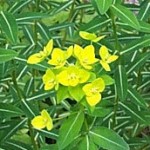 Wallich spurge is a clump forming herbaceous perennial native the Himalayas. It is a member of the spurge family, Euphorbiaceae, that also includes poinsettia, caster-oil plant, and cassava. The lanceolate leaves dark green with a white midrib before turning yellow or orange in the fall. The flower-like structure appears terminal clusters in early spring and lasts for months. It is four to six inches across, lacks sepals or petals, and consists of three yellow bracts surrounding a cyanthium that is formed by the fusion of a single stamen (male) and a long stalked ovary (female). The stems are coral red and contain a milky sap that may be irritating to the skin and eyes.
Wallich spurge is a clump forming herbaceous perennial native the Himalayas. It is a member of the spurge family, Euphorbiaceae, that also includes poinsettia, caster-oil plant, and cassava. The lanceolate leaves dark green with a white midrib before turning yellow or orange in the fall. The flower-like structure appears terminal clusters in early spring and lasts for months. It is four to six inches across, lacks sepals or petals, and consists of three yellow bracts surrounding a cyanthium that is formed by the fusion of a single stamen (male) and a long stalked ovary (female). The stems are coral red and contain a milky sap that may be irritating to the skin and eyes.
Type: Herbaceous perennial
Bloom: Clusters of flower like structures composed of three yellow bracts in spring for a long bloom time
Size: 24-30” H x 18” W
Light: Sun to part shade (especially in the South)
Soil: Average, moist, well-drained
Hardiness: Zones 6-9
Care: Cut back flowering shoots to ground level in late summer or autumn.
Pests and Diseases: None of significance
Propagation: Basal cuttings, division, seed with 4 to 6 week cold period
Companion plants: Salvia sylvestris, Salvia nemorosa, purple leafed Heuchera, Frikart’s aster, Crocosmia ‘Jennine’